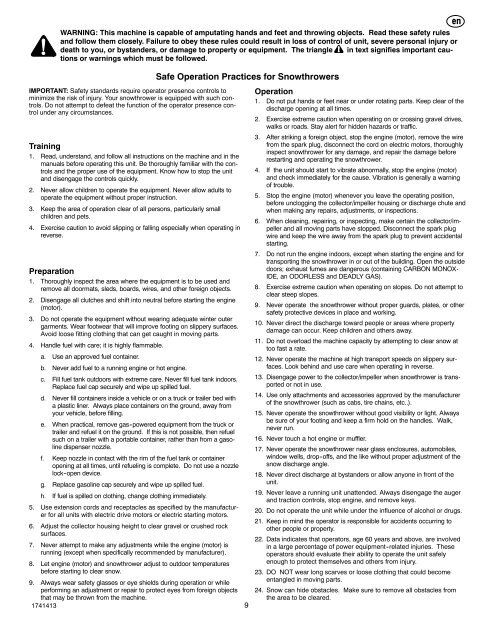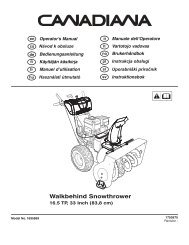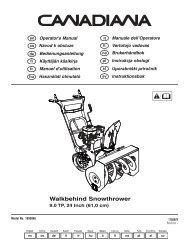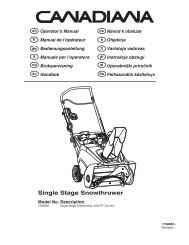Instruction Book - Snowthrower Model 6210701x54NA ... - Canadiana
Instruction Book - Snowthrower Model 6210701x54NA ... - Canadiana
Instruction Book - Snowthrower Model 6210701x54NA ... - Canadiana
Create successful ePaper yourself
Turn your PDF publications into a flip-book with our unique Google optimized e-Paper software.
WARNING: This machine is capable of amputating hands and feet and throwing objects. Read these safety rules<br />
and follow them closely. Failure to obey these rules could result in loss of control of unit, severe personal injury or<br />
death to you, or bystanders, or damage to property or equipment. The triangle in text signifies important cautions<br />
or warnings which must be followed.<br />
IMPORTANT: Safety standards require operator presence controls to<br />
minimize the risk of injury. Your snowthrower is equipped with such controls.<br />
Do not attempt to defeat the function of the operator presence control<br />
under any circumstances.<br />
Training<br />
1. Read, understand, and follow all instructions on the machine and in the<br />
manuals before operating this unit. Be thoroughly familiar with the controls<br />
and the proper use of the equipment. Know how to stop the unit<br />
and disengage the controls quickly.<br />
2. Never allow children to operate the equipment. Never allow adults to<br />
operate the equipment without proper instruction.<br />
3. Keep the area of operation clear of all persons, particularly small<br />
children and pets.<br />
4. Exercise caution to avoid slipping or falling especially when operating in<br />
reverse.<br />
Preparation<br />
1. Thoroughly inspect the area where the equipment is to be used and<br />
remove all doormats, sleds, boards, wires, and other foreign objects.<br />
2. Disengage all clutches and shift into neutral before starting the engine<br />
(motor).<br />
3. Do not operate the equipment without wearing adequate winter outer<br />
garments. Wear footwear that will improve footing on slippery surfaces.<br />
Avoid loose fitting clothing that can get caught in moving parts.<br />
4. Handle fuel with care; it is highly flammable.<br />
a. Use an approved fuel container.<br />
b. Never add fuel to a running engine or hot engine.<br />
c. Fill fuel tank outdoors with extreme care. Never fill fuel tank indoors.<br />
Replace fuel cap securely and wipe up spilled fuel.<br />
d. Never fill containers inside a vehicle or on a truck or trailer bed with<br />
a plastic liner. Always place containers on the ground, away from<br />
your vehicle, before filling.<br />
e. When practical, remove gas--powered equipment from the truck or<br />
trailer and refuel it on the ground. If this is not possible, then refuel<br />
such on a trailer with a portable container, rather than from a gasoline<br />
dispenser nozzle.<br />
f. Keep nozzle in contact with the rim of the fuel tank or container<br />
opening at all times, until refueling is complete. Do not use a nozzle<br />
lock--open device.<br />
g. Replace gasoline cap securely and wipe up spilled fuel.<br />
h. If fuel is spilled on clothing, change clothing immediately.<br />
5. Use extension cords and receptacles as specified by the manufacturer<br />
for all units with electric drive motors or electric starting motors.<br />
6. Adjust the collector housing height to clear gravel or crushed rock<br />
surfaces.<br />
7. Never attempt to make any adjustments while the engine (motor) is<br />
running (except when specifically recommended by manufacturer).<br />
8. Let engine (motor) and snowthrower adjust to outdoor temperatures<br />
before starting to clear snow.<br />
9. Always wear safety glasses or eye shields during operation or while<br />
performing an adjustment or repair to protect eyes from foreign objects<br />
that may be thrown from the machine.<br />
1741413<br />
Safe Operation Practices for <strong>Snowthrower</strong>s<br />
9<br />
en<br />
Operation<br />
1. Do not put hands or feet near or under rotating parts. Keep clear of the<br />
discharge opening at all times.<br />
2. Exercise extreme caution when operating on or crossing gravel drives,<br />
walks or roads. Stay alert for hidden hazards or traffic.<br />
3. After striking a foreign object, stop the engine (motor), remove the wire<br />
from the spark plug, disconnect the cord on electric motors, thoroughly<br />
inspect snowthrower for any damage, and repair the damage before<br />
restarting and operating the snowthrower.<br />
4. If the unit should start to vibrate abnormally, stop the engine (motor)<br />
and check immediately for the cause. Vibration is generally a warning<br />
of trouble.<br />
5. Stop the engine (motor) whenever you leave the operating position,<br />
before unclogging the collector/impeller housing or discharge chute and<br />
when making any repairs, adjustments, or inspections.<br />
6. When cleaning, repairing, or inspecting, make certain the collector/impeller<br />
and all moving parts have stopped. Disconnect the spark plug<br />
wire and keep the wire away from the spark plug to prevent accidental<br />
starting.<br />
7. Do not run the engine indoors, except when starting the engine and for<br />
transporting the snowthrower in or out of the building. Open the outside<br />
doors; exhaust fumes are dangerous (containing CARBON MONOX-<br />
IDE, an ODORLESS and DEADLY GAS).<br />
8. Exercise extreme caution when operating on slopes. Do not attempt to<br />
clear steep slopes.<br />
9. Never operate the snowthrower without proper guards, plates, or other<br />
safety protective devices in place and working.<br />
10. Never direct the discharge toward people or areas where property<br />
damage can occur. Keep children and others away.<br />
11. Do not overload the machine capacity by attempting to clear snow at<br />
too fast a rate.<br />
12. Never operate the machine at high transport speeds on slippery surfaces.<br />
Look behind and use care when operating in reverse.<br />
13. Disengage power to the collector/impeller when snowthrower is transported<br />
or not in use.<br />
14. Use only attachments and accessories approved by the manufacturer<br />
of the snowthrower (such as cabs, tire chains, etc..).<br />
15. Never operate the snowthrower without good visibility or light. Always<br />
be sure of your footing and keep a firm hold on the handles. Walk,<br />
never run.<br />
16. Never touch a hot engine or muffler.<br />
17. Never operate the snowthrower near glass enclosures, automobiles,<br />
window wells, drop--offs, and the like without proper adjustment of the<br />
snow discharge angle.<br />
18. Never direct discharge at bystanders or allow anyone in front of the<br />
unit.<br />
19. Never leave a running unit unattended. Always disengage the auger<br />
and traction controls, stop engine, and remove keys.<br />
20. Do not operate the unit while under the influence of alcohol or drugs.<br />
21. Keep in mind the operator is responsible for accidents occurring to<br />
other people or property.<br />
22. Data indicates that operators, age 60 years and above, are involved<br />
in a large percentage of power equipment--related injuries. These<br />
operators should evaluate their ability to operate the unit safely<br />
enough to protect themselves and others from injury.<br />
23. DO NOT wear long scarves or loose clothing that could become<br />
entangled in moving parts.<br />
24. Snow can hide obstacles. Make sure to remove all obstacles from<br />
theareatobecleared.








